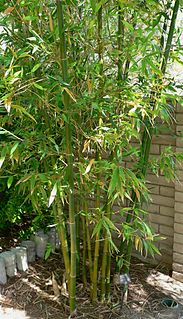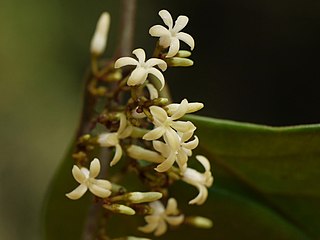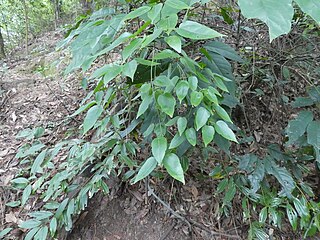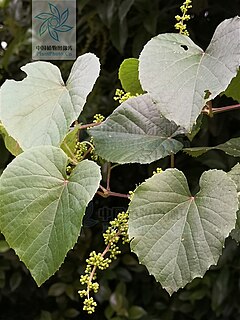
Bambusa is a large genus of clumping bamboos. Most species of Bambusa are rather large, with numerous branches emerging from the nodes, and one or two much larger than the rest. The branches can be as long as 11 m (35 ft).

Anodendron is a genus of plant in the family Apocynaceae first described as a genus in 1844. It is native to China, the Indian Subcontinent, Southeast Asia, New Guinea, and some islands of the western Pacific.
- Anodendron affine(Hook. & Arn.) Druce - China, Japan, Ryukyu Islands, Philippines, Vietnam, Laos, Thailand, Myanmar, Bangladesh
- Anodendron axillareMerr. - Philippines, Borneo, W Malaysia, Java, Sumatra
- Anodendron benthamianumHemsl. - Taiwan
- Anodendron borneense(King & Gamble) D.J.Middleton - Borneo, Palawan
- Anodendron candolleanumWight - Thailand, W Malaysia, Borneo, Java, Sumatra, Philippines
- Anodendron coriaceum(Blume) Miq. - Thailand, W Malaysia, Borneo, Java, Bali, Lombok, Timor, Flores
- Anodendron gracile(King & Gamble) D.J.Middleton - Borneo, Palawan, W Malaysia
- Anodendron howiiTsiang - Guangxi, Hainan
- Anodendron nervosumKerr - Yunnan, Assam, Laos, Thailand, Vietnam, Java, Sumatra
- Anodendron oblongifoliumHemsl. - Borneo, Philippines, Maluku, New Guinea, Bismarck Archipelago, Solomon Islands, Vanuatu
- Anodendron paniculatum(Roxb.) A.DC. - India, Bangladesh, Sri Lanka, Andaman & Nicobar Is, Malaysia, Indonesia, Philippines
- Anodendron pauciflorumHook.f - Borneo, W Malaysia, Sumatra
- Anodendron punctatumTsiang - Cambodia, Thailand, Guangxi, Hainan, Sichuan
- Anodendron seramenseD.J.Middleton - Maluku
- Anodendron tubulosum(Ridl. ex Burkill & M.R.Hend.) D.J.Middleton - W Malaysia, Sumatra
- Anodendron whitmoreiD.J.Middleton - Maluku, New Guinea, Solomon Islands
- Anodendron wrayiKing & Gamble - W Malaysia
Vitis mengziensis is a species of plant in the grape family. It is found in the province of Yunnan in China, where it is known by the name meng zi pu tao, meaning Mengzi or Mengtze grape. The specific epithet mengziensis and vernacular Chinese name refer to Mengzi, a county in the southeast of Yunnan. It grows in temperate rainforests, at elevations near 1600 meters.
Vitis hui is a species of plant in the grape family. It is native to Jiangxi and Zhejiang provinces in China, where it is called lu shan pu tao, meaning Mount Lushan grape. It grows in temperate climes, at elevations between 100 and 200 meters in shrublands and along the edges of open meadows.
Vitis ruyuanensis is a species of polygamo-dioecious plant in the grape family native to the Chinese province of Guangdong. Here it grows in shrublands or along hillsides at around 200 meters. Flowers, blooming between April and May, give way to the development of globular berries in June and July.
Vitis yunnanensis is a species of liana in the grape family native to the Chinese province of Yunnan. It is a forest dweller, found at various elevations between 500 and 1800 meters. In August it bears globular berries.
Vitis wuhanensis is a tropical or sub-tropical, polygamo-dioecious species of liana in the grape family native to the Chinese provinces of Henan, Hubei and Jiangxi, found in valleys and along hillsides, in forests or shrublands, at elevations from 300 up to 700 meters. It flowers in April and May, and bears globular berries as early as May, and as late as July.
Vitis betulifolia is a widely ranging species of liana in the grape family native to China where its habitat is forested or shrubby valleys and hillsides, at elevations from 600 to 3,600 metres.

Vitis sinocinerea, commonly known as the lobular grape or small-leaved grape, is a species of climbing vine in the grape family ranging widely over much of the Chinese mainland as well as Taiwan. In Chinese it is known as xiao ye pu tao, which can be translated as small-leaved grape. Its natural habitat is within forested or shrubby hills.
Vitis menghaiensis is a species of climbing vine in the grape family native to China. It is found in mixed forests around 1500–1600 meters above sea-level. It flowers in May, and male flowers have non-functioning ovaries.
Vitis fengqinensis is a species of wild Chinese grape native to Yunnan province, where it is known by the name feng qing pu tao, meaning Fengking grape. It is generally found on shrubby slopes at about 2000 meters above sea-level. Its fruits come out in June.
Vitis chungii is a polygamo-dioecious species of wild grape native to China where it is known by the name min gan pu tao, or Fujian Jianxi grape. It is a forest inhabitant, 200–1000 meters above sea-level, on hillsides, in valleys, or other areas having wild, shrubby growth. It bears globular, ruddy-purple berries, 8–10 mm in diameter.

Vitis bryoniifolia is a prolific and adaptable, polygamo-dioecious species of climbing vine in the grape family native to China, where it is known as ying yu, or hua bei pu tao. The variant form ternata is known as san chu ying yu, meaning three-foliolate, or -leaflet ying yu. Ying yu translates to mean "hard jade".
Vitis heyneana is a species of climbing vine in the grape family endemic to Asia. It can be found in shrubby or forested areas, from almost sea-level, to 3200 meters above. It has globose berries that are purple to almost black.
Vitis chunganensis is a species of climbing vine in the grape family native to China. In Chinese it is called dong nan pu tao, or Southeast grape.

Toxocarpus is a genus of plants in the family Apocynaceae. It is native to China, the Himalayas, and Southeast Asia.

Ottelia acuminata, is a plant species endemic to Southern China.

Acer cordatum is an Asian species of maple. It has been found only in China.

Vitis pseudoreticulata, commonly known as the wild Chinese grape or eastern Chinese grape, is a Chinese liana in the grape family. It is native to eastern China, specifically the provinces of Anhui, Fujian, Guangdong, Guangxi, Henan, Hubei, Hunan, Jiangsu, Jiangxi, and Zhejiang. The plant grows at altitudes of 100–300 m (330–980 ft) and bears medium-sized purplish-black grapes. It has been observed to be resistant to damage from moisture, white rot, anthracnose, and Downy mildew.

Vitis bellula, commonly known as the beautiful grape or small leaf hair grape, is a Chinese liana in the grape family. It is native to the provinces of Guangdong, Guangxi, Hubei, Hunan, and Sichuan. The plant grows at altitudes of 400–1,600 m (1,300–5,200 ft) and bears medium-sized purplish-black grapes.








